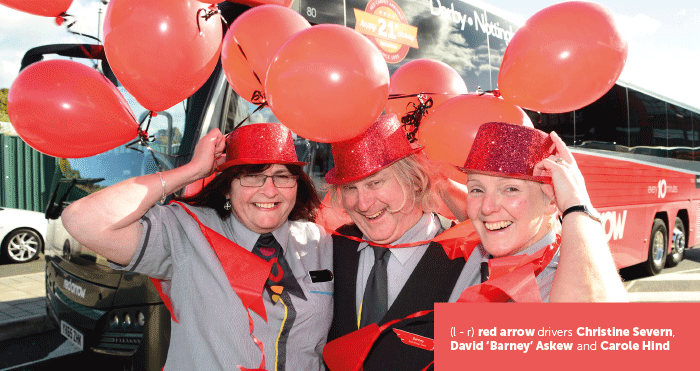21 year old red arrow hits its prime
The non-stop red arrow coach service between Derby and Nottingham is 21 years old this week, with the luxury coach service in celebration mood for customers. Thursday 20 October and Friday it will be party time on red arrow and at Derby Bus Station and Nottingham’s Victoria, with balloons, birthday breakfasts and special birthday beer for passengers. The coaches are sporting birthday decorations and drivers will be donning party hats. The hugely popular red arrow service, which now runs every ten minutes at peak times and additional leg room at every seat.
Jordan Kemp, marketing and communications manager at trentbarton, said: “Looking back at red arrow’s history it is fascinating to see how fresh the vision was and how innovative times between the two city centres, is the flagship route for the bus company trentbarton. More than a million passengers ride on red arrow each year".
Last year red arrow received a £3 million boost with nine new luxury coaches each with free 4G wifi and tables at every seat. The top of the range British-built coaches also feature USB charging points for phones, tablets and laptops, bike storage for cyclists and extra wide reclining leather seats.
Jordan added “The service was a major breakthrough, one that has inspired other cities’ transport operators and helped both Nottingham and Derby to develop as places to work, study and play. I’ve no doubt red arrow’s future will be as exciting and pioneering.”
The red arrow drivers
Among the 32 regular drivers on the route are David Askew, who has been driving red arrows for 19 of the 21 years, and Carole Hind, the reigning – and first female – UK Bus Driver of the Year. David is known to colleagues and passengers on the buses as ‘Barney’. He explains: “When I started at trentbarton there were half a dozen Davids driving, so I was named Barney – after Barney Rubble – and it has stuck, when I’m at work.
“I’ve seen plenty of changes over the years. There have been five generations of coaches. Each of them was good, and they’ve got better and better. The ones we drive now are beautiful.” ‘Barney’, who lives in Duffield, said: “When red arrow started it was like a holiday coach. Groups of people would get on together, like they were on an outing. “Back then customers would get on with a book or a newspaper and read, now it’s a smart phone or a laptop and they watch a film. “Another change has been the roads. The A52 is very different now.
But I think there have always been roadworks somewhere on it. There’s not a section that hasn’t been played with. “I’ve made friends with customers over the years. I’ll never forget a lady who got on at the QMC. She was a bit sharp with me but it was because her husband had just died. We sat and talked about it and she still says thank you. “There are funny things to remember too. My red arrow broke down once – a linkage had popped out. After I got the passengers transferred to another coach, we were at a loss what to do. “But I’m a keen photographer and remembered I had a big rubber band I kept around my batteries so used that as a running repair and limped back to Meadow Road. “I’ve never wanted to move to a different service. I love that as a driver you are out and away for three or four hours. And it’s diverse – you never know what you are going to come across each day. “My partner, Debbie, is also a red arrow driver. I wooed her from the spondon flyers and she came across to the red arrow.”
Carole, from Chadderton, was last November crowned the first ever female winner of the UK Bus Driver of the Year. She has been driving red arrows since July 2010, five months after first taking up bus driving. Carole said: “I wouldn’t want to do any anything else. The coaches are lovely to drive and are so comfortable. They are also very manoeuvrable. As drivers we’re quite spoilt really, and the customers love them too.”

The red arrow history
There had been a Derby-Nottingham express service (X42, later 101 then R1) jointly run by Trent and Barton but it fizzled out in the 1980s. In the 1990s trentbarton identified how important journey speed was to customers. So although it had grown the overall Derby-Nottingham market, the bus routes did not follow the natural route that one would ever think of driving, they made frequent stops and took over an hour. Comfort for the journey was important, particularly for people to switch from driving (or using the train) if trentbarton could put an attractive enough show on the road. The first red arrow launched in 1995 to cut the hour-plus journey time between the two cities. Several names were tested but red arrow was the original favourite, suggesting speed and directness. The comfort of a coach was the luxury ingredient, riding high above the traffic so that people could enjoy a view of the world passing by, and distinguishing the brand from other bus routes. red arrow was a hit, exactly as the research had predicted, although trentbarton was taken aback by just how far afield people would travel from to connect to the service.
At first, red arrows ran once an hour. By 1997 it was every half hour and the frequency doubled again to every 15 minutes in 2003 when late evening and Sunday services also began. The frequency stimulated further growth, as ‘turn up and go’ departures appealed to many customers. night arrow was trentbarton’s first venture into late night buses, encouraged by the cities’ large universities. red arrow now runs until 3.30am on Friday and Saturday nights – its late night coaches have risen in popularity and helped boost the night time economies in both Derby and Nottingham. Free wifi put passengers online from 2010, when coaches also started running beyond 3am on Friday and Saturday nights. Throughout its 21-year history red arrow has never needed a penny in public subsidy. red arrow is a route where passenger numbers continue to grow. In 2015 there were almost 1.5 million red arrow passenger journeys, including the Derby to Chesterfield comet link – a 200,000 increase on 2013. red arrow has seen five generations of buses: Barton DAF (1995-1996); Plaxton/Volvo B10 (1996-2004); Inter-Century (2004-2015); Irizar i4 (2010-2015); and the current Plaxton/Volvo Elite. Each week the red arrow fleet’s drivers clock up a total of almost 25,000 miles on the road.

